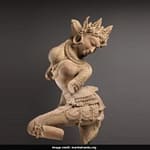A team of students and faculty of Arignar Anna Government Arts College and researchers has uncovered archaeological evidence of habitation sites dating to the Sangam period on the bank of the Pambai river at Ayyankoyilpattu and Thennamadevi-Anaimedu near Villupuram.
“A collection of scattered antiquities such as spindle whorls, gamesmen, ear-ornaments, spouts, lid knobs, besides beads of semi-precious stones like carnelian, banded agate, paste (glass) of various colours and shapes, a copper coin dating to medieval Chola period provided ample evidence to show that a Sangam era habitation site had existed on the river bank,” said D. Ramesh, Assistant Professor of History, Arignar Anna Government Arts College.
Antiquities dating to the Sangam period found on the bank of the Pambai River, near Villupuram.
| Photo Credit:
Special arrangement
The evidence came to light when Sathish Kumar and Veeravel, first-year students of the Department of History found the antiquities during a visit and informed their Associate Professor D. Ranganathan, Mr. Ramesh and archaeological expert M. Cheran.
The cultural mound at Thennamadevi-Anaimedu stretches to a length of 500 to 600 metres covering an expanse of 10 acres while the mound at Ayyankoyilpattu covers a land mass of more than 15 acres.
The antiquities including black and red ware, red slipped ware and red ware were found on the northern bank of the Pambai river. The habitation site came to light after the recent flooding under the impact of Cyclone Fengal that had washed away the surface deposit of the cultural mound.
“The cultural accumulation found exposed on the surface is very much suggestive of early historical materials dating to the Sangam period. The antiquities at both the sites included etched barrel shaped carnelian beads, button shaped and truncated quartz beads, besides a copper coin with tiger and double fish symbols of King Uttama Chola,” Mr. Ramesh said.
In addition, the team also recovered beads of agate, banded agate and glass (paste) of various sizes, colours and shapes were also recovered. The find also included the broken portion of the frontal view of a female figurine, spindle whorls, gamesmen, ear ornaments, hopscotches, beads and seals.
The eroded surface revealed medium to coarser variety of black and red ware, coarser to finer fabric of black ware, red slipped ware, red ware besides portions of storage jars and vessel, one full portion of finely ground polished small chisel like celt (neolithic tool) and a broken portion of a bi-facial polished stone axe.
“From these finds it is inferable that the portion of the mound found at Thennamadevi-Anaimedu is considered as a potential cultural mound with material remains very much related to the early historic deposit. In 1987, the Department of Ancient History and Archaeology, University of Madras, conducted an excavation at Thiruvamathur, located in close vicinity to the explored sites of Thennamadevi-Anaimedu and Ayyankoyilpattu. The recent find indicates the continuity of the settlement pockets at various locations of Pambai River pertaining to early historical period,” Mr. Ramesh added.
Published – January 06, 2025 05:07 pm IST












Remove
SEE ALL